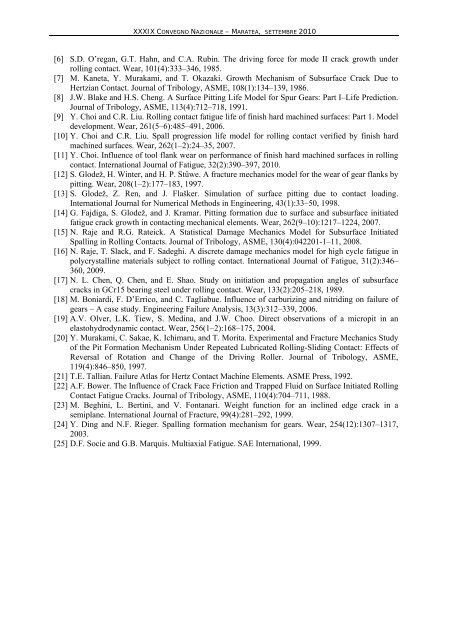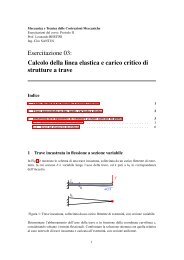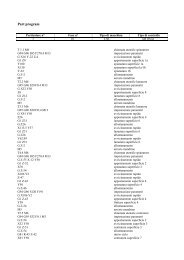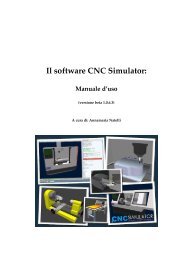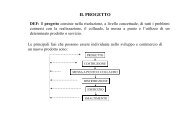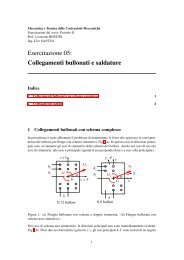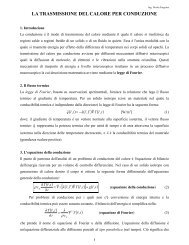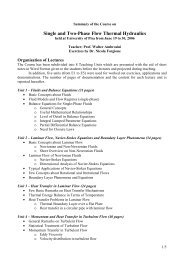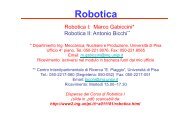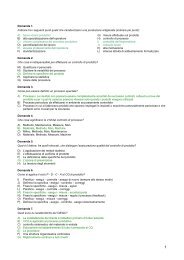<strong>XXXIX</strong> CONVEGNO NAZIONALE – MARATEA, SETTEMBRE 2010la finitura superficiale non fosse particolarmente spinta (caso classico di sola rettifica) il meccanismodi danneggiamento che è lecito attendersi è quello di Pitting/Micropitting, piuttosto che quello diSpalling. In tal caso si determina il valore di resistenza del meccanismo superficiale, mentre quellosub-superficiale non si manifesta. Queste osservazioni hanno due importanti conseguenze:• dal momento che la sollecitazione sub-superficiale non è molto influenzata dall’attrito, lamassima resistenza in termini di fatica da contatto, si ottiene per il caso di superfinitura, percui si manifesta il meccanismo di Spalling;• il valore di resistenza del meccanismo superficiale, Pitting/Micropitting è funzione nonsoltanto del materiale (sicuramente correlato con il livello di durezza dell’acciaio) ma anchedel parametro tribologico λ, mente invece il parametro di carico non dipende dalla rugosità, senon in modo marginale mediante il coefficiente di attrito.4. CONCLUSIONIIl presente lavoro riporta un concisa ma completa ricerca bibliografica sulla fatica da contatto, e ladescrizione della fisica di ciascuno dei meccanismi di danneggiamento. I principali risultati delpresente studio sono:1. Al fine di discriminare il manifestarsi del danneggiamento non è significativo descrivere lapropagazione ma, piuttosto, la nucleazione. I parametri di danneggiamento proposti sonoquindi di nucleazione. Per lo spalling non si descrive come la fessura superficiale possapropagare o coalescere con altre fessure sub-superficiali limitrofe, si caratterizza invece ilmanifestarsi della prima fessura sub-superficiale. Analogamente per il Pitting, la modellazionedella pressurizzazione ha come obbiettivo soltanto quello di ottenere la dimensionecaratteristica sulla quale determinare il taglio ciclico medio, piuttosto che modellare lasuccessiva propagazione della fessura, che oltretutto è molto rapida nel caso superficiale.2. La dimensione caratteristica di Pitting risulta essere molto simile alla corrispondenteprofondità di Micropitting (tipicamente 10 μm), per condizioni operative molto comuni nelleruote dentate e nei cuscinetti a rotolamento, ossia pressione massima Hertziana elevata,larghezza di contatto ridotta. In tale situazione l’evoluzione della microfessura può essere difratturazione o di rapida propagazione verso la superficie, ma non è possibile un significativoaumento di profondità. Mentre invece la dimensione del danneggiamento di Spalling rimanelegata alla dimensione del contatto e quindi, tipicamente, molto maggiore di quella diPitting/Micropitting.3. Gli indici di danneggiamento proposti offrono la possibilità di confrontare una condizione dicarico riprodotta in laboratorio, ad esempio mediante banco a dischi (che permette uncontrollo molto accurato del contatto) con la condizione di carico del componente in esercizio,in modo da permettere una progettazione e/o verifica accurata, qualora siano disponibili delleprove sperimentali specifiche.BIBLIOGRAFIA[1] A.V. Olver. “The mechanism of rolling contact fatigue: an update”. Proceedings of the Institutionof Mechanical Engineers, Part J: Journal of Engineering Tribology, 219(5), 313-330, 2005.[2] D. Nélias, M.L. Dumont, F. Couhier, G. Dudragne, and L. Flamand. Experimental andTheoretical Investigation on Rolling Contact Fatigue of 52100 and M50 Steels Under EHL orMicro-EHL Conditions. Journal of Tribology, ASME, 120(2):184–200, 1998.[3] D. Nélias, M.L. Dumont, F. Champiot, A. Vincent, and D. Girodin. Role of Inclusions, SurfaceRoughness and Operating Conditions on Rolling Contact Fatigue. Journal of Tribology, ASME,121(2):240–251, 1999.[4] J.R. Fleming and N.P. Suh. Mechanics of crack propagation in delamination wear. Wear,44(1):39–56, 1977.[5] L.M. Keer and M.D. Bryant. A pitting model for rolling contact fatigue. Journal of LubricationTechnology, ASME, 105:198–205, 1983.
<strong>XXXIX</strong> CONVEGNO NAZIONALE – MARATEA, SETTEMBRE 2010[6] S.D. O’regan, G.T. Hahn, and C.A. Rubin. The driving force for mode II crack growth underrolling contact. Wear, 101(4):333–346, 1985.[7] M. Kaneta, Y. Murakami, and T. Okazaki. Growth Mechanism of Subsurface Crack Due toHertzian Contact. Journal of Tribology, ASME, 108(1):134–139, 1986.[8] J.W. Blake and H.S. Cheng. A Surface Pitting Life Model for Spur Gears: Part I–Life Prediction.Journal of Tribology, ASME, 113(4):712–718, 1991.[9] Y. Choi and C.R. Liu. Rolling contact fatigue life of finish hard machined surfaces: Part 1. Modeldevelopment. Wear, 261(5–6):485–491, 2006.[10] Y. Choi and C.R. Liu. Spall progression life model for rolling contact verified by finish hardmachined surfaces. Wear, 262(1–2):24–35, 2007.[11] Y. Choi. Influence of tool flank wear on performance of finish hard machined surfaces in rollingcontact. International Journal of Fatigue, 32(2):390–397, 2010.[12] S. Glodež, H. Winter, and H. P. Stűwe. A fracture mechanics model for the wear of gear flanks bypitting. Wear, 208(1–2):177–183, 1997.[13] S. Glodež, Z. Ren, and J. Flašker. Simulation of surface pitting due to contact loading.International Journal for Numerical Methods in Engineering, 43(1):33–50, 1998.[14] G. Fajdiga, S. Glodež, and J. Kramar. Pitting formation due to surface and subsurface initiatedfatigue crack growth in contacting mechanical elements. Wear, 262(9–10):1217–1224, 2007.[15] N. Raje and R.G. Rateick. A Statistical Damage Mechanics Model for Subsurface InitiatedSpalling in Rolling Contacts. Journal of Tribology, ASME, 130(4):042201-1–11, 2008.[16] N. Raje, T. Slack, and F. Sadeghi. A discrete damage mechanics model for high cycle fatigue inpolycrystalline materials subject to rolling contact. International Journal of Fatigue, 31(2):346–360, 2009.[17] N. L. Chen, Q. Chen, and E. Shao. Study on initiation and propagation angles of subsurfacecracks in GCr15 bearing steel under rolling contact. Wear, 133(2):205–218, 1989.[18] M. Boniardi, F. D’Errico, and C. Tagliabue. Influence of carburizing and nitriding on failure ofgears – A case study. Engineering Failure Analysis, 13(3):312–339, 2006.[19] A.V. Olver, L.K. Tiew, S. Medina, and J.W. Choo. Direct observations of a micropit in anelastohydrodynamic contact. Wear, 256(1–2):168–175, 2004.[20] Y. Murakami, C. Sakae, K. Ichimaru, and T. Morita. Experimental and Fracture Mechanics Studyof the Pit Formation Mechanism Under Repeated Lubricated Rolling-Sliding Contact: Effects ofReversal of Rotation and Change of the Driving Roller. Journal of Tribology, ASME,119(4):846–850, 1997.[21] T.E. Tallian. Failure Atlas for Hertz Contact Machine Elements. ASME Press, 1992.[22] A.F. Bower. The Influence of Crack Face Friction and Trapped Fluid on Surface Initiated RollingContact Fatigue Cracks. Journal of Tribology, ASME, 110(4):704–711, 1988.[23] M. Beghini, L. Bertini, and V. Fontanari. Weight function for an inclined edge crack in asemiplane. International Journal of Fracture, 99(4):281–292, 1999.[24] Y. Ding and N.F. Rieger. Spalling formation mechanism for gears. Wear, 254(12):1307–1317,2003.[25] D.F. Socie and G.B. Marquis. Multiaxial Fatigue. SAE International, 1999.


